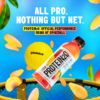The pantry is becoming a stocking ground for protein-rich products. And that holds potential for center store, thanks to the myriad protein-enhanced staples retailers can market to today’s protein-focused shoppers.
“We’re witnessing a protein revolution, with 32% of consumers specifically looking for protein on food labels,” says Dave Melbourne, Bumble Bee Seafoods’ SVP of consumer marketing and corporate social responsibility. “And we’ve seen healthy, protein-based snack options increase more than 40% since 2009 as consumers continue to look for nutritious, affordable solutions to fill their pantries and fuel their busy lifestyles.”
What’s driving consumers’ penchant for protein-rich products? In a word: health
“Protein is top of mind when consumers think about a healthy diet,” says Karen Buch, founder of Nutrition Connections LLC, who has worked extensively with retail dietitians. Sixty-four percent of Americans actively seek to consume more protein, Buch says.
The fact that protein benefits all age groups helps drive sales, says Shari Steinbach, president of Shari Steinbach & Associates, who works with food companies, health professionals and consumers in retail settings. “Children need adequate protein for building a healthy brain and body,” says Steinbach, who served as a dietitian for two major Midwest food retailers for more than two decades. “Successful weight management has been associated with a high-protein diet … and athletes and older individuals are looking for ways to maintain and build muscle.”
Whey protein also helps curb appetite and aids in muscle recovery and building energy, says Andy Horrow, president of protein drink manufacturer Protein2o. “This appeals to fitness and workout enthusiasts, but it also has great appeal to weight-conscious and weight loss populations,” Horrow says. “Protein has become the foundation of healthy.”
Another consideration: “Protein leads to satiety,” says Linda Zink, SVP of innovation at Atkins Nutritionals Inc. “Consumers are realizing they need that optimal protein to feel full longer and have more consistent energy.”
Labels Matter
High protein content is definitely a plus, but it won’t boost a product’s sales potential unless it is touted where consumers can see it—which is especially true for younger shoppers.
“The first thing millennials do when they pick up a packaged food is flip it over and look at the nutrition panel,” says Peter Burns, president and CEO of One Brands, maker of One Bars. “They are no longer choosing foods based on taste alone but based on the functionality it provides their bodies.”
“We believe consumers are smarter, and label reading is now expected with progressive consumers looking to understand what they are putting into their bodies,” says Jennifer Bacon, co-founder and chief brand officer of FlapJacked, maker of Protein Pancake & Baking Mixes, Protein Cookie & Baking Mixes and Mighty Muffins.
Promoting Protein in Center Store
“It’s widely known that the center store has been an increasingly challenging space for packaged brands to gain traction as the emphasis on fresh foods continues to grow on the perimeter.”
That statement from Ryan Therriault—VP of marketing and innovation at Amazing Grass, maker of protein shakes, bars and powders—describes the hurdle retailers face as they seek to build business beyond the perimeter.
The increasing prevalence of better-for-you products, including those boasting high protein content, are helping retailers clear that hurdle.
“With the rise and popularity of health and wellness products, we are seeing the center of the store gaining more relevance as companies clean up their labels,” Bacon says.
Creative merchandising and marketing can go a long way toward building center-store sales.
Amazing Grass, for example, has used endcap displays to create product awareness, and created temporary displays outside of center store in the fresh produce and dairy departments, Therriault reports: “Our consumers are often purchasing these items, along with our proteins, to make fresh smoothies, so it’s a natural fit that also drives basket size for the retailer.”
The following ideas offer some creative ways to start building center store profits with protein:
- Offer recipes that require center store protein ingredients. Such recipes “often have the added benefit of affordability compared to recipes that focus on higher-priced fresh perimeter protein sources,” Buch says.
- Use shelf edge tags to call out high-protein products. This approach can move beyond “passive tagging,” Buch says. “Retailers can create temporary price reduction sales programs, ad features and in-store displays focused on the full grouping of products that qualify for a protein claim.”
- Tap in-store dietitians. Buch suggests offering protein-themed “Fuel Up for Fitness” or “Power of Protein” store tours, during which dietitians guide consumers toward protein sources.
- Provide protein-powered demos. “One of my favorite recipes to demo when I worked at retail was a Greek pasta with tomatoes and beans,” Steinbach recalls. “We drove sales of a new higher-protein pasta and canned beans.”
- Don’t ignore the pharmacy. “Bring the protein message to the pharmacy for older shoppers and those managing their weight,” Bach says. “Provide education on the benefits of protein in the diet and offer a shopping list and recipes that build a bridge to the food aisles.”
- Create a low-carb/high-protein section. “Adding protein to center aisle items like cereals, wraps [and] snack bars has been on-trend for some time,” Zink says. “The problem is, many still contain a high amount of carbohydrates. While consumers need the satiating effects of more protein, the over-consumption of carbohydrates is still an issue and cannot be ignored.”
- Put natural products head to head with conventional ones. “It’s a win-win for retailers and natural products manufacturers,” Bacon says. “The consumer wins with healthier products; the retailers and manufacturers win with higher cart values.”
A recent Nielsen report reminds producers and manufacturers to “continue to iterate health benefits, nutrition and clean labeling in order to meet consumers’ demand for the most healthful protein options available.”
Whatever approach retailers ultimately choose, one thing is clear: Investing in protein-enhanced products can enhance profits, too.
http://www.winsightgrocerybusiness.com/wellness/protein-rich-products-perk-center-store




